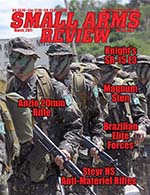By Julio A. Montes
The Ivema Bochica Gun Truck
The explosion shook the crew violently as their vehicle staggered heavily from side to side. Minutes after the explosion the occupants, all unharmed and without wounds, exited the vehicle. The Bochica had been damaged by a mine, which had been detonated to the right and not directly underneath the machine. Although there were components that had been bent and torn by the explosion, the Bochica was repaired in just a short time, allowing it to continue its task. This was not an attack of the narco-guerrilla but rather a test of the Gila APC developed by the International Vehicle & Equipment Marketing (Ivema) from South Africa. André Mouton, the company's Director of Operations, tells us that although the Gila follows the typical silhouette and "V" floor of the Casspir, it is actually a new vehicle built under the specifications established by the Colombian Army. Once in Colombia for testing, the vehicle received the name of Bochica, and was put to the test.
The designer of the project and representatives of Ivema insisted that the tests of explosives were carried out with crew complement to demonstrate not only the capacities of the vehicle cross-country, but also the high level of protection provided. This meant a Colombian Special Forces motorized squad in its interior. The Colombian Army actually received a handful of the APCs to test in country. André Mouton explains the details of the machine, pointing that the Gila is wider than the Casspir, measuring 6,390mm in length, 2,500mm width, 2,750mm height, and 3,800mm base. These dimensions translated into added and improved comfort to the crew, but also in greater stability. The vehicle fits perfectly inside the C130, facilitating deployment.
Another consideration, especially useful for export and international deployment, is that the vehicle is modified from left to right side driving without any mayor structural change. The vehicle is already set for driving one way or another by simply switching the steering wheel from left to right and vice versa by unplugging and plugging back some components. Time was taken to introduce other mechanical improvements and increase the level of protection against explosions and mines, which now exceeds NATO standards (4569 Stanag Level 4). The new vehicle has a combat weight of 9,720kg, with a payload of 2,280 @ 12,000 (13.600kg margin), and a gross weight of 12,000kg. The Gila was ready in May of 2006. Mouton tells us that the Colombians requested a purely transport variant with the crew seating facing each other and with an interior space for a crew of 2 and 9 motorized infantrymen. One of the consequences was that interior space available for equipment was reduced. The turret was specified to be simple and limited to a single heavy machine gun, having a traverse of 360 degrees. The mechanical components were placed in modular form and those more delicate implements were placed within the protective armor. The modules allow the adaptation of a number of details. The originally selected engine is the Mercedes-Benz Euro-3 turbocharged diesel 4800cc, developing 215hp (160kw), with a maximum torque of 780 Nm @ 1200-1800 rpm. Although the engine is a 4 cylinder model, it produces more force and is much more efficient and reliable than the V8 used in the Casspir. Another advantage of this particular engine is its easy availability on the commercial market in South Africa as well as in Colombia, and most countries of the world. The Mercedes Euro-3 pushes the vehicle to a maximum speed of 105km/h, and allowing it to surpass gradients of 60 degrees. The 28V electrical system depends from a 100 Amp alternator.
Mouton also gave us a look of a mock up of a Gila modified to Brazilian Federal Police Department (DPF) requirements. The DPF prefers a combat infantry variant, with back-to-back seats to allow the use of firing ports by the mounted squad. The turret is fixed, but equipped with viewfinders and four small firing ports for the use of small arms from the interior. The DPF model has been equipped with protective shields that fold over the frontal bulletproof glass windows. Each vehicle costs about USD $400,000. On the other hand, 23 overhauled Casspirs were sold to Peru, with 20 going to the Police and 3 to the Naval Infantry.
Ivema tells us that the tests were successful in Colombia, but was not clear if additional machines were ordered. Then in April, Ivema announced the first order of 12 Gilas by an undisclosed African customer.
This article first appeared in Small Arms Review V14N6 (March 2011) |
| SUBSCRIBER COMMENT AREA |
Comments have not been generated for this article.







